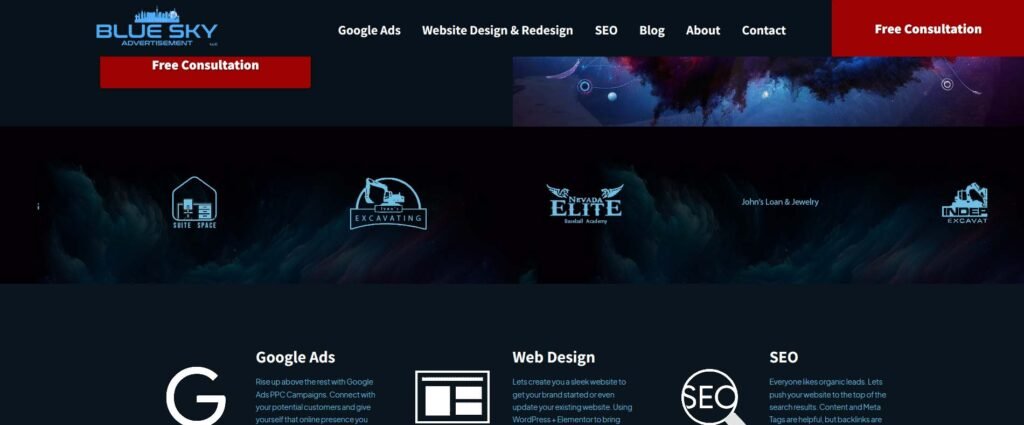Table of Contents
How To Measure The Success Of Your Small Business Using Data-Analytics.

As a small business owner, having a website is essential for reaching your target audience and growing your business. However, simply having a website is not enough. To ensure that your website is helping you achieve your business goals, let us help you figure out how to its success.
Measuring your website’s success is crucial for understanding how your website is performing, what is working well, and what needs improvement. Website analytics and performance metrics provide valuable insights into your website’s effectiveness and help you make data-driven decisions to optimize its success.
Website success indicators vary depending on your business goals and website objectives. However, some common indicators include website traffic, user behavior, conversion rates, and engagement metrics. These indicators provide a holistic view of your website’s performance and help you identify areas for improvement.
Key Takeaways
- The essentials for measuring your website’s success and how to grow using the data for your small business.
- Website analytics and performance metrics provide valuable insights into your website’s effectiveness.
- Spotting your website’s success indicators like website traffic, user behavior, conversion rates, and engagement metrics.
- How to track your website’s analytics to help your small businesses identify areas for improvement.
- How to use your website’s analytic data and performance metrics to make data-driven decisions.
Tracking Your Website's Traffic And SEO Analytics
Measuring website traffic is key to understanding the effectiveness of your online presence. It allows you to track the number of visitors to your website, where they came from, and how they engage with your content. By analyzing website traffic data, you can identify areas for improvement and optimize your website for better performance.
Website analytics tools provide valuable insights into your website’s performance. They track website traffic, user behavior, and engagement metrics, giving you a comprehensive view of your website’s success. Popular website analytics tools include Google Analytics 4, Google Search Console, SEM Rush, and Ahrefs.
Here are 4 ways that tracking your website traffic helps your business:
- Identify your most popular pages and content
- Determine the source of your website traffic, such as search engines, social media, or referral sites
- Track the behavior of your website visitors, including their click paths and session lengths
- Measure the success of your website’s calls-to-action and conversion rates

Website Analytic Terms To Track
Website analytics provides a lot of information about your website’s performance. By using and understanding these analytic terms you can gain insights into user behavior, engagement metrics, and conversion rates. Here are 5 key website analytics metrics to track :
| Metric | Description |
|---|---|
| Pageviews | The number of times a page has been viewed |
| Unique visitors | The number of individual visitors to your website |
| Bounce rate | The percentage of visitors who left your website after viewing only one page |
| Session duration | The average amount of time visitors spend on your website |
| Conversion rate | The percentage of visitors who completed a desired action, such as filling out a form or making a purchase |
Please take into consideration that page views should be taken with a grain of salt. Google Analytics 4 is NOT 100% accurate and you should use New Users as the main indicator. We here at Blue Sky Advertisement have been using GA4 and Google Universal Analytics over the years and we have come to this conclusion over the last 5 years.
Here are some additional website engagement metrics that can give you great insights into how users interact while on your website:
- Number of comments and shares on a blog post or social media post
- Time spent on your money making pages or interaction with videos
- Number of submissions or newsletter sign-ups
- Overall engagement rate with certain sections of your website page
Track Your SEO Progress
Using Google Analytics 4 and Google Search Console to track your website’s SEO progress is crucial for evaluating its visibility in search engine results. Monitoring your SEO performance will allow you to determine which areas of your website needs improved to increase your ranking in search engine results pages (SERPs).
Here are 6 key website ranking factors that influence SEO performance:
- Website speed and loading time
- Mobile responsiveness
- The layout of your website
- Domain age and authority
- High-quality and relevant content
- Backlinks from reputable sources
Google Analytics 4 and Google Search Console helps you track your website’s SEO performance and identify areas for improvement. These tools allow you to analyze keyword rankings, track organic search traffic, and measure click-through rates (CTRs) for different pages on your website. Using these tools can help you identify gaps in your strategy to improve your account.
Another way to improve your account is to find gaps in your competitors SEO strategy to exploit and gain from it. You can use tools like SEM Rush to be able to easily find those gaps. Please remember SEO is a long term investment. It is NOT a quick fix to your business’s problem.
Top 3 Website Success Indicators And How To Improve Them
Measuring website success is critical for small businesses to evaluate their online presence. By analyzing key performance metrics, user behavior, and SEO, you can gauge the effectiveness of your website and make data-driven decisions to optimize its performance.
Here are 3 things you should consider when measuring your website’s success.
- Conversion Rates
- User Engagement
- SEO Performance
Website's Conversion Rate (CR)
Conversion rates measure the percentage of visitors who take the desired action you want them to take on the website, such as making a purchase, signing up for a newsletter or filling out a form. Analyzing conversion rate data can also provide insights into user behavior and preferences. For example, tracking which pages on your website have the highest conversion rates can help you identify what content or offers are most appealing to your audience.
To improve conversion rates, consider testing different variations of your website design, copy, and calls-to-action. Use A/B testing to evaluate which changes lead to the most significant increase in conversions.
You can track conversion rates using website analytics tools like Google Analytics 4. Monitoring your conversion rates every few days and optimizing your website for better performance is crucial for small businesses to achieve their online goals. AB testing home page or service pages monthly, changing CTA button colors, adding more CTA sections, and making your content more engaging are options you can take to increase your CR.
Here is one of the recent home page changes we did here at Blue Sky Advertisement for a Private Office Space company’s home page.
Old Home Page

New Home Page

Website's User Engagement
By using User engagement and website engagement metrics you can measure how visitors interact with your website, including how long they stay on a page and how many pages they visit. This information can help you optimize your website for higher conversion rates.
Some essential user engagement metrics to track include:
- Time on Site
- Pages per Session
- Bounce Rate
You can track user engagement metrics using website analytics tools like Google Analytics 4.
Improve Your Website's Design and Layout
The design of your website plays a critical role in engaging users. A poorly designed website can lead to a high bounce rate and negatively impact website engagement metrics. Therefore, consider updating your website design to make it more visually appealing and user-friendly.
You can achieve this by including relevant images or videos that highlight your products or services. Also, consider using a clear and easy-to-read font to assist users in navigating your website quickly. If your website looks professional, users are more likely to trust the quality of your products or services.
Here is an example of how to improve the User-experience of your website:
Sticky Header

Making your header into a sticky header allows the user to easily access the other pages of your website.
Make Your Content More Engaging
Users want to obtain valuable information when they visit a website. Consider providing useful content to engage users and keep them on your website longer. The content provided should be unique, informative, and relevant to your target audience. This will show users that you care about their experience and are willing to provide value to them.
Ensure that your content is easy to read and formatted correctly. Use subheadings, bullet points, and short paragraphs to break up the text and make it easy to digest. This will keep users engaged and retain their attention throughout the article or page.
Here is one example on how to make content more engaging for the typical user:
We took a flat design and made it pop out to make it more engaging and easier to read for the user with one of our recent web design projects

From Flat Design To Pop-Out

Enhancing Your Website's UX (User-Experience)
Providing a great user experience is another essential way to engage users. You can achieve this by optimizing website speed and performance, offering personalized product recommendations, and ensuring site navigation is simple and straightforward.
Moreover, provide easy-to-use navigation menus and clear calls-to-action to ensure users can quickly and effortlessly find what they are looking for. Ensure that your website is optimized for both desktop and mobile devices to cater to a broad range of users.
Taking the time to optimize website engagement will significantly increase website performance metrics and lead to a more successful small business website.
Monitoring your conversion rates every few days and optimizing your website for better performance is crucial for small businesses to achieve their online goals. AB testing home page or service pages monthly, changing CTA button colors, adding more CTA sections, and making your content more engaging are options you can take to increase your CR.
Tracking Your Website's SEO Performance
SEO performance metrics measures how well your website ranks in search engine results pages. Successful SEO performance indicates that your website is at the top of the search results and is attracting organic traffic. To make it simple: more potential leads.
Some essential SEO performance metrics to track include:
- Keyword Rankings
- Organic Search Traffic
- Backlinks
You can track SEO performance metrics using website analytics tools, such as Google Search Console, SEM Rush, Ahrefs, and other third-party SEO software. SEM Rush is costly option starting at $120, but it is worth the money. It helps you track your keywords overtime to confirm your SEO efforts are showing success. Google Search Console is the free option if you connect it to your domain.
The 5 Main Website Ranking Factors
In addition to these performance metrics, tracking website ranking factors and SEO performance is also crucial for small businesses. By optimizing your website for SEO, you can improve its visibility in search engine results, driving more traffic and ultimately more conversions.
Some key website ranking factors include:
- Content relevance and quality
- Website structure and organization
- Mobile optimization
- Link quality and quantity
- Website authority on a certain topic(s)
By tracking these performance metrics and website ranking factors, small businesses can make informed decisions to optimize their website for success.
Conclusion
In conclusion, measuring website success is essential for small businesses to unlock their online potential. By understanding website analytics, performance metrics, and user behavior, you can optimize your website for success.
Please remember tracking conversion rates, engagement metrics, and SEO performance can provide valuable insights to improve your website’s success. By making data-driven decisions, you can drive growth and achieve your business goals. Understanding website success indicators is crucial for evaluating the overall performance of your small business website. By interpreting these indicators, you can make informed decisions and drive growth.
FAQ
Why is measuring website success important for small businesses?
Measuring website success allows small businesses to evaluate the effectiveness of their online presence and make data-driven decisions to drive growth and achieve business goals.
What role does website analytics play in measuring website success?
Website analytics provide valuable insights into website performance, including metrics such as traffic analysis, conversion rates, and user engagement. By analyzing these data, small businesses can understand how their website is performing and make informed optimization strategies.
What are key performance metrics that small businesses should track?
Key performance metrics to track include website ranking factors, SEO performance, conversion rates, engagement metrics, and website traffic analysis. These metrics provide important indicators of website success and help small businesses identify areas for improvement.
How can user behavior tracking contribute to website success?
Tracking user behavior allows small businesses to understand how visitors interact with their website. By analyzing engagement metrics and user behavior, businesses can optimize website design, content, and overall user experience for better performance and success.
How do conversion rates impact website success?
Conversion rates measure the percentage of website visitors who take a desired action, such as making a purchase or filling out a contact form. Analyzing and improving conversion rates are crucial for boosting website success and achieving business objectives.
What strategies can be employed to optimize website engagement?
Strategies to optimize website engagement include improving website design, providing valuable content, enhancing user experience, and implementing effective call-to-action elements. These strategies can increase user engagement and contribute to overall website success.
How does SEO impact website success?
SEO plays a significant role in determining website success by enhancing its visibility in search engine results. Small businesses should focus on understanding key ranking factors and implementing effective SEO strategies to improve their website’s performance and drive organic traffic.








